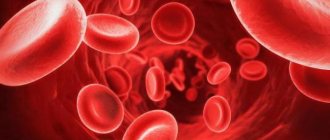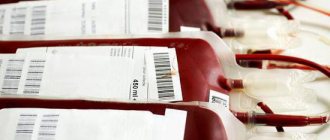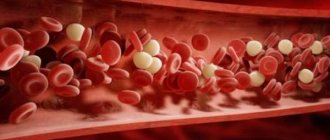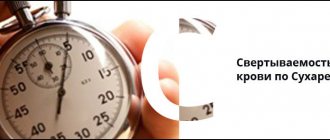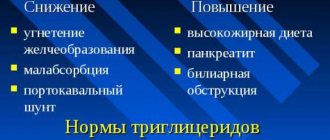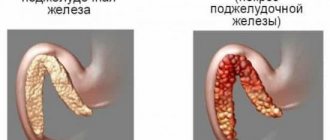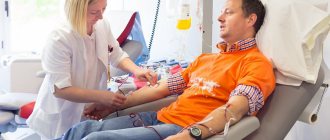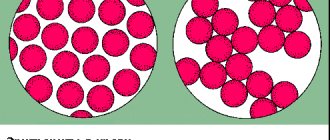Tsoliclone is a monoclonal antibody produced by genetic engineering. Most often, mice are used to obtain it - a special antigen is injected into the animal, and then rodent ascites fluid is obtained, which contains the indicated antibodies. Morphologically, they belong to class M immunoglobulins, i.e. acute phase antibodies. Their mechanism of action is due to the formation of an antigen-antibody complex, where some molecules (in this situation, proteins that determine the blood group and its Rh) located on the cell membrane act as antigens.
Why is the analysis carried out?
Group and Rh factor are genetically determined blood characteristics that are inherited from parents and remain unchanged throughout a person’s life.
. The classification of blood groups is carried out based on a certain set of biochemical parameters and the composition of antigens, and has 4 main groups. Transfusing a patient with blood of an incompatible group or with a different Rh factor carries with it a mortal danger - the immune system begins to produce antibodies against foreign cells that attack and destroy them. It is for this reason that in situations that carry the risk of extensive blood loss, it is necessary to accurately determine the blood identity and Rh factor of both the donor and the recipient.
What are zoliclones?
Tsoliklon is a saline solution of monoclonal antigens to human erythrocyte antibodies. Monoclonal antibodies are used to determine blood group. To obtain them, hybridoma technology is used. Anti-A and anti-B zoliclones were created to determine human blood groups of the ABO system instead of standard isohem agglutinating sera.
Coliclones anti-A and anti-B are hybridoma products of cell lines acquired as a result of the fusion of mouse antibody-producing B lymphocytes with mouse tumor cells (bone marrow myeloma). Personal hybridomas produce bands of homogeneous antibodies only of the 1st class, which, immunoglobulins, are entirely similar in structure and bio Antibodies. The activities produced by cells of the 1st clone (offspring of one cell) are monoclonal.
In antibodies, cells of the same specificity, originating from the 1st form, lymphocyte cells of the 1st clone. The main thing is that you need to: then get special antibodies from one cell and develop them in huge quantities. The difficulty lies in overcoming two tasks: firstly, ordinary cells die after several divisions; secondly, only cancer cells are capable of multiplying indefinitely. To solve these two incomparable problems, G. Köhler and K. Milstein made cell modifications or hybridomas in 1975. Hybridomas are the fusion of ordinary lymphocytes in a nutrient medium with lymphocyte cells. myelomas do not die in this environment, and from the myeloma they receive a partner the opportunity to endlessly reproduce. In a similar hybridoma way, the clan multiplies, and as a result of this process, monoclonal antibodies are formed.
Coliclone anti-D IgG
Anti-D IgG zolicone is used to detect all types of red blood cell D antigen. Allows detection of weak Du antigen and variants DI - DVII. It is used in the indirect antiglobulin test and in the conglutination reaction with gelatin.
The reagent is used:
- as a clarifying diagnostic tool for identifying partial variants of the DI - DVII antigen in samples of donor erythrocytes, which, in reaction with monoclonal anti-D IgM reagents, were initially determined to be D-negative;
- as an independent reagent for identifying all types of antigen D: D, Du, DI - DVII.
The active principle of the diagnosticum is human monoclonal IgG antibodies. Produced by a human-mouse heterohybridoma cell line.
How is the research conducted?
To determine a blood group using cyclones, you need a flat, even surface (plate) moistened with water, a set of chemical reagents and biological fluid samples, and a specialist can use any blood: capillary, venous, frozen, etc.
- The sides of the tablet are marked so as not to confuse which of them will be applied to one or another type of zoliclones.
- One drop of reagents (usually anti-A and anti-B cyclones) and blood are dropped onto the surface, and the volume of chemicals should be 8-10 times greater than the volume of the biomaterial.
- Wait 3-5 minutes, gently rocking the plate so that the liquids are well mixed and red blood cells do not settle around the edges of the samples.
After a few minutes, a reaction will occur, by which it is possible to determine with high accuracy whether the blood belongs to a certain group.
Decoding the results
Determination of the group of erythrocyte antigens and the Rh factor has long become one of the mandatory studies for most patients admitted for hospital treatment. It can be carried out at any level of medical care, provided that the necessary reagents and instruments are available.
Typically, group determination is carried out using standard sera, although it is competed by another method, similar in methodology to the reference one, using zoliclones.
Coliclone is a monoclonal antibody produced by genetic engineering. Most often, to obtain it, mice are used; a special antigen is injected into the animal, and then rodent ascites fluid is obtained, which contains the indicated antibodies.
Morphologically, they belong to class M immunoglobulins, i.e. acute phase antibodies. Their mechanism of action is due to the formation of an antigen-antibody complex, where some molecules (in this situation, proteins that determine the blood group and its Rh) located on the cell membrane act as antigens.
Table. Reactions of different blood groups with anti-A and anti-B zoliclone.
| Blood type | Reaction with zoliclone anti-A | Reaction with zoliclone anti-B |
| Group I | Absent | Absent |
| Group II | Positive | Absent |
| III group | Absent | Positive |
| IV group | Positive | Positive |
Coliclone anti-D Super or anti-D IgM
Coliclone anti-D IgM Super is used to determine the Rh status of blood by detecting the D antigen of erythrocytes. The reagent agglutinates most D-positive blood samples with the exception of red blood cells with partial antigen DVI.
In the absence of agglutination with anti-D IgM, a clarifying study of donor blood samples is carried out using Tsoliklon anti-D IgG. The reagent detects the presence of weak antigens or variants of the D antigen. The anti-D IgG test is not performed on recipients.
The active principle of the diagnosticum is human monoclonal IgM antibodies produced by a heterohybridoma human-mouse cell line.
Specificity of anti-D IgM
The reagent agglutinates D-positive red blood cells. Does not give an agglutination reaction with D-negative erythrocytes and blood cells with partial antigen DVI.
What should you consider when conducting your analysis?
In order for the analysis result to be as reliable as possible, a number of conditions must be met during the procedure:
- reagents should be stored in a cool place at a temperature of +2-8 degrees in bottles with a tightly screwed cap (if storage rules are violated, they quickly lose their properties);
- For analysis, you cannot use cyclones that have expired (about 30 days) or liquids that contain sediment, flakes or debris;
- the study is performed in a well-lit room at an air temperature of no lower than +15 and no higher than +25 degrees, and there should be no dirt, dust or other factors that can distort the result;
- when applying biomaterial and reagents to the surface of the tablet, the proportions must be strictly observed - if there is too much blood, the reaction is more difficult to track, and in the opposite case (with a small volume) it will be too slow;
- Drops of blood mixed with different types of zoliclones should not be allowed to merge together - if this happens, the test is carried out again; for the same reason, different sticks should be used to mix reagents with biomaterial.
The reaction duration should be at least 3 minutes, and if the result is questionable, the observation time for biomaterial samples should be extended to 5 minutes. However, after 10 minutes, the biomaterial may dry out and red blood cells may naturally precipitate, so you should not trust such a study.
Determination of Rh factor
To determine the Rh factor, you will need anti-D zolicone. It is a colorless liquid and is also sold in small bottles with a dispenser. To carry out the reaction, one additional drop of blood is enough, which is placed separately on the tablet. The procedure is carried out according to the following scheme:
- apply a 0.1 ml drop of anti-D coliclone to the glass;
- add a drop of blood next to it, the volume of which is 0.01 ml;
- use a glass rod to combine the two liquids and gently move the glass so that the blood and the reagent are mixed;
- after 3 minutes record the result.
The first results can be viewed in 15 seconds, but it is important to wait 3 minutes to determine the final result. The presence of a result, that is, the appearance of an agglutination reaction, indicates that the Rh factor is positive, its absence indicates a negative Rh factor.
REFERENCE! Agglutination is expressed by the appearance of red flakes consisting of red blood cells, which can be seen with the naked eye, without special conditions and equipment.
The analysis is deciphered according to the table; red blood cell agglutination is considered a positive result
Why is analysis necessary?
Currently, zoliclones are used primarily to determine blood group and Rh factor. The study can be carried out as planned, as prescribed by a local physician, or for emergency indications when a blood transfusion is required (massive blood loss occurred during the operation or the patient was delivered with extensive trauma and massive bleeding). In the clinic, group determination is carried out mainly through the use of sera.
Blood group based on cyclones is most often determined in a hospital or specialized laboratories. The use of zoliclones is usually resorted to when it is impossible to use serums. The speed of obtaining results is somewhat faster than when testing with standard sera, which makes the technique more universal. Many laboratories are trying to switch to using this method.
